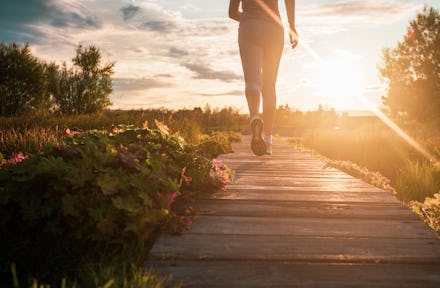How to safely exercise when it's hot as hell out

Because of our limited (or lack of) access to the gym, many of us have been taking our workouts outdoors. I’ve been running about three miles a day since the pandemic began, but by the time my morning run ends, it’s already over 80 degrees and I’m sweating and exhausted. Getting your butt kicked by a good run always feels good, but I’m starting to wonder if — when it’s this hot — there’s a thin line between feeling tired and feeling sick. Is there a way to work out safely in the heat?
The first thing that you need to know is that it’s fine to work out when it’s hot. “Generally, it is okay to work out in the heat as long as you adjust your workouts and exercise accordingly,” says Jarrod Harrall, a Colorado-based sports medicine physician and team physician at the United States Olympic Training Center. But, he adds, it’s really important for people to be aware of their current fitness status so they can determine if they are acclimatized to exercising in the heat.
What Harrall is saying is that you need to be honest with yourself about how fit you are and how much heat you can usually handle. If, for example, you are just wading back into a workout routine or tend to overheat easily, you are going to need to temper your workouts according to the temperature and your fitness level. Basically, if you’re an A/C-addicted couch potato, it’s probably unwise to try to run a marathon tomorrow. Even more unwise to do it in the height of summer.
“Activities that allow frequent breaks, minimal body equipment, and training sessions that last less than an hour are generally safer,” Harrall says. So, keep your training sessions short, take breaks, and save the heavy kettlebells for inside. What should you do? Keep it short and frequent. “I love a good 30 and 15 minute workout in the heat,” Tom Holland, a fitness advisor at Bowflex, tells me. “Thirty minutes of cardiovascular exercise and 15 minutes of strength training.”
Holland cites a great routine that can be adjusted to many fitness levels. For the 30 minutes of cardio, Holland says, do 10 minutes of easy running, five one-minute sprints, and then cool down with 10 more minutes of easy running. For the strength portion of the workout, Holland recommends doing five exercises that use body weight instead of equipment. Do a minute of push-ups, one minute of squats, one minute of bicycle crunches, one minute of alternating lunges, and one minute of plank. Rinse and repeat three times. I love the sound of this routine so much that I’m doing it as soon as I get off work.
You might want to use those frequent breaks you’ll be taking to hydrate, because staying hydrated was the number one concern the experts I spoke with had about working out in the heat. And — this is really important — you need to hydrate even if you don’t feel thirsty. “Thirst is not a good indicator of your hydration status,” Harrall explains. “Athletes don’t sense ‘thirst’ until they become more than 5% dehydrated.” Dehydration affects your performance and can also be dangerous. Harrall advises folx to track their fluid and electrolyte intake during workouts and even consider pre- and post-workout weight to make sure you aren’t losing too much fluid during a workout.
We usually equate hydration with water — for obvious reasons — your sweat is made of more than just water. “You lose two crucial things in your sweat: fluid and electrolytes,” Holland explains. The theory is that if you lose more than just water when you work out, you want to replenish with more than just water. Water can’t replace electrolytes that are being lost in your sweat, Nat Favini, a San Francisco-base internist tells Mic. He suggests a sports beverage if you’re exercising outside in hot weather.
I hate sports drinks. They’re neon, jock-bro-ey, and often contin tons of sugar. Don’t worry, though, you can make your own. “A natural alternative would be coconut water or creating your own sports drink consisting of fluid and electrolytes,” says Holland. To be clear, you would need to add sodium, potassium, and magnesium to a beverage to make it rich enough in electrolytes to equate to a bottled product, he explains. That chemistry is a little too complicated for my morning routine, so I think I’ll be sticking to coconut water.
So, be honest with yourself about your fitness, have a short, strategic workout routine, stay hydrated, and you’re safe to proceed with #hotpersonsummer. The only other thing you need to be aware of is the heat index, which looks at a combination of temperature and relative humidity. “You should exercise caution when the heat index is in the 80s, extreme caution in the 90s and low 100s,” Favini says. If you’re above 103 on the heat index, Favini says he doesn’t recommend exercising outside. You’ll just have to stay inside with the kettlebells or your favorite vintage Fonda.